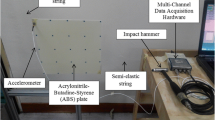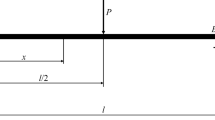Abstract
Orthotropic elastic moduli of composite structures can be identified by nonlinear least squares fit between measured and computed natural frequencies. However, due to measurement errors contained in the measured natural frequencies and mode shapes, the process of elastic moduli identification is error-prone. This paper proposes an efficient method to estimate the errors in the elastic moduli caused by the measurement errors in the natural frequencies. The method utilizes an efficient semi-analytic expression of the sensitivities of the eigenvalues with respect to the orthotropic elastic moduli. First, the first-order approximation of the analytic sensitivity of orthotropic elastic moduli with respect to the measurement errors is introduced. The approximation is then used to estimate the variability of the identified elastic moduli due to the measurement errors. It is shown that the aspect ratio of the test specimen greatly affects the standard deviation of the identified elastic moduli. Second, using the first-order approximation, the effects of aspect ratio of the test specimen as well as the values of the elastic moduli are further investigated. Based on the results of numerical experiments, guidelines for the dimension of the test specimen for the elastic moduli identification are proposed.
















Similar content being viewed by others
References
Araújo AL, Mota Soares CM, Herskovits J, Pedersen P (2009) Estimation of piezoelastic and viscoelastic properties in laminated structures. Compos Struct 87(2):168–174
Araújo A, Soares CM, de Freitas MM, Pedersen P, Herskovits J (2000) Combined numerical & experimental model for the identification of mechanical properties of laminated structures. Compos Struct 50 (4):363–372
Barkanov E, Wesolowski M, Hufenbach W, Dannemann M (2015) An effectiveness improvement of the inverse technique based on vibration tests. Comput Struct 146:152–162
Cugnoni JC, Gmür T, Schorderet A (2007) Inverse method based on modal analysis for characterizing the constitutive properties of thick composite plates. Comput Struct 85(17–18):1310–1320
Gladwell GML (2011) Matrix inverse eigenvalue problems. In: Gladwell GML, Morassi A (eds) Dynamical Inverse Problems: Theory and Application, Springer Wien New York, 1–28
Gogu C, Haftka R, Le Riche R, Molimard J (2010) Effect of approximation fidelity on vibration-based elastic constants identification. Struct Multidiscip Optim 42(2):293–304
Gogu C, Yin W, Haftka R, Ifju P, Molimard J, Le Riche R, Vautrin A (2013) Bayesian Identification of Elastic Constants in Multi-Directional Laminate from Moirè Interferometry Displacement Fields. Exp Mech 53:635–648
Jiang D, Li Y, Fei Q, Wu S (2015) Prediction of uncertain elastic parameters of a braided composite. Compos Struct 126:123–131
Jones RM (1999) Mechanics of Composite Materials. Taylor & Francis, New York
Lasn K, Echtermeyer AT, Klauson A, Chati F, Décultot D (2015) Comparison of laminate stiffness as measured by three experimental methods. Polym Test 44:143–152
Lauwagie T, Sol H, Heylen W (2006) Handling uncertainties in mixed numerical-experimental techniques for vibration based material identification. J Sound Vib 291(3-5):723–739
Lauwagie T, Lambrinou K, Sol H, Heylen W (2010) Resonant-based identification of the Poissons ratio of orthotropic materials. Exp Mech 50(4):437–447
Lauwagie T, Sol H, Roebben G, Heylen W, Shi Y, der Biest OV (2003) Mixed numerical-experimental identification of elastic properties of orthotropic metal plates. NDT & E Int 36(7):487–495
Lee C, Kam T (2006) Identification of mechanical properties of elastically restrained laminated composite plates using vibration data. J Sound Vib 295(3–5):999–1016
Mair M, Weilharter B, Rainer S, Ellermann K, Bíró O (2013) Numerical and experimental investigation of the structural characteristics of stator core stacks. COMPEL: The International Journal for Computation and Mathematics in Electrical and Electronic Engineering 32(5):1643–1664
Matter M, Gmür T, Cugnoni J, Schorderet A (2009) Numerical-experimental identification of the elastic and damping properties in composite plates. Compos Struct 90(2):180–187
Mogenier G, Baranger TN, Dufour R, Durantay L, Baras N (2010) Efficient model development for an assembled rotor of an induction motor using a condensed modal functional. J Comput Nonlinear Dyn 6(2):021011 8
Oliveira S, Toader AM, Vieira P (2012) Damage identification in a concrete dam by fitting measured modal parameters. Nonlinear Anal Real World Appl 13(6):2888–2899
Pagnotta L (2008) Recent progress in identification methods for the elastic characterization of materials. Int J Mech 2(4):129–140
Perkins NC, Mote CD (1986) Comments on curve veering in eigenvalue problems. J Sound Vib 106 (3):451–463
Saito A, Nishikawa Y, Yamasaki S, Fujita K, Kawamoto A, Kuroishi M, Nakai H (2016) Equivalent orthotropic elastic moduli identification method for laminated electrical steel sheets. Mech Syst Signal Process 72-73:607–628
Taylor WR, Roland E, Ploeg H, Hertig D, Klabunde R, Warner MD, Hobatho MC, Rakotomanana L, Clift SE (2002) Determination of orthotropic bone elastic constants using FEA and modal analysis. J Biomech 35(6):767–773
Thite AN, Thompson DJ (2003) The quantification of structure-borne transmission paths by inverse methods. Part 1: improved singular value rejection methods. J Sound Vib 264:411–431
Acknowledgments
The authors would like to thank Dr. Masato Tanaka and Dr. Ryuji Omote of Toyota Central R&D Labs., Inc., and Dr. Hidetaka Saomoto of National Institute of Advanced Industrial Science and Technology for fruitful discussions regarding the treatment of measurement errors and the elastic moduli identification method.
Author information
Authors and Affiliations
Corresponding author
Rights and permissions
About this article
Cite this article
Saito, A., Kawamoto, A., Kuroishi, M. et al. Estimation of measurement errors in orthotropic elastic moduli determined from natural frequencies. Struct Multidisc Optim 55, 987–999 (2017). https://doi.org/10.1007/s00158-016-1552-9
Received:
Revised:
Accepted:
Published:
Issue Date:
DOI: https://doi.org/10.1007/s00158-016-1552-9




